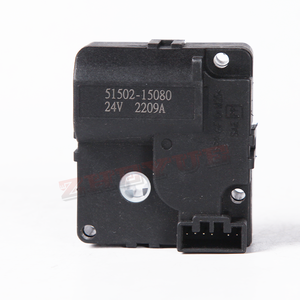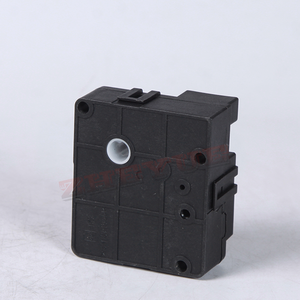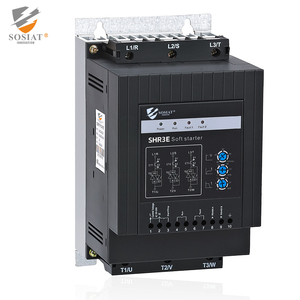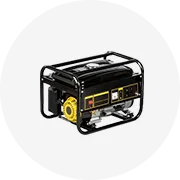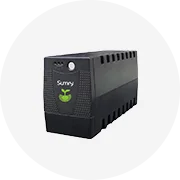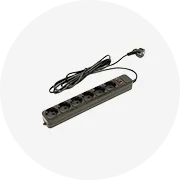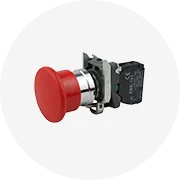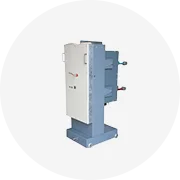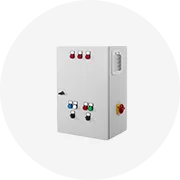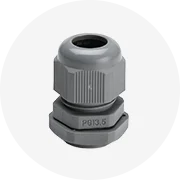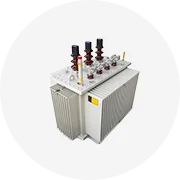Types of Medium Voltage Motor Starters
Medium voltage motor starters are specialized devices designed to control and protect medium voltage motors (typically 1kV to 15kV) used in industrial and utility applications. They provide essential functions including starting, stopping, and protecting motors from overloads, short circuits, and other electrical faults.
Reduced Voltage Starters
These starters reduce mechanical and electrical stress during motor startup by limiting initial voltage or current.
Best for: High-inertia loads, power grid limitations, extending motor life
Variable Frequency Drives (VFD)
Advanced starters that control motor speed by varying frequency and voltage, providing outstanding energy efficiency and precise speed control.
Best for: Applications requiring variable speeds, energy optimization, soft starting/stopping
Full Voltage Starters
Connect motors directly to power supply at full voltage, delivering maximum starting torque but creating high inrush currents.
Best for: Applications requiring high starting torque, simple installations, robust industrial environments
Expert Tip: When selecting a medium voltage motor starter type, consider not only current application requirements but also future expansion. VFDs offer the most flexibility but at higher initial cost, while reduced voltage starters provide a good balance between performance and investment.
Detailed Breakdown of Reduced Voltage Starters
| Type | Operation | Advantages | Limitations |
|---|---|---|---|
| Autotransformer Starters | Connects autotransformer to motor terminals at start, providing reduced voltage before disconnecting at full speed | Higher starting torque per line current, smooth acceleration | More expensive, requires maintenance of transformer taps |
| Secondary Voltage Drop Resistor | Uses series resistors during start, later short-circuited when motor reaches target speed | Simple design, good for wound rotor motors | Energy lost as heat in resistors, limited torque control |
| Soft Starters | Controls voltage using solid-state devices (SCRs or thyristors), gradually ramping up voltage | Smooth acceleration, reduced mechanical stress, programmable start profiles | Higher cost, heat generation, harmonics introduction |
| Direct-on-Line (DOL) | Directly connects motor to power supply at full voltage | Simple, reliable, low cost, maximum starting torque | High inrush current (5-8x rated), mechanical stress |
| Full Voltage Reversing | Similar to DOL but with capability to reverse motor rotation | Simple direction control, full torque in both directions | Complex interlock requirements, high inrush currents |
Specifications and Maintenance of Medium Voltage Motor Starters
Regular maintenance is crucial for ensuring the reliability, efficiency, and safety of medium voltage motor starters. A comprehensive maintenance program extends equipment lifespan and prevents costly downtime in industrial operations.
| Maintenance Category | Key Activities | Recommended Frequency |
|---|---|---|
| Regular Inspection | Visual checks, connection tightening, vibration assessment, component inspection | Monthly |
| Electrical Maintenance | Insulation resistance testing, cable inspection, power quality analysis | Quarterly |
| Mechanical Maintenance | Lubrication of moving parts, cooling system cleaning, alignment checks | Quarterly |
| Control & Protection | Function testing, protection device calibration, setting verification | Semi-annually |
| Thermal Assessment | Thermal imaging, hotspot detection, temperature monitoring | Semi-annually |
| Documentation | Maintenance records, test results, component replacement logs | After each maintenance |
Maintenance Tip: Implement a predictive maintenance approach using thermal imaging and vibration analysis to detect issues before they cause failures. This can reduce unplanned downtime by up to 45% and extend equipment life by 20-40%.
Critical Maintenance Tasks
Electrical Maintenance
Insulation Testing: Use megger testing to measure insulation resistance and detect deterioration before failures occur.
Connection Integrity: Thermal scan and torque verification of all electrical connections prevent high-resistance connections that lead to overheating.
Warning: Never perform insulation testing without complete isolation from power sources.
Mechanical Maintenance
Moving Components: Lubricate contactors and mechanical linkages with manufacturer-recommended lubricants.
Cooling Systems: Clean heat sinks, check fan operation, and ensure proper airflow to prevent thermal damage.
Best practice: Document baseline vibration readings for comparison during future maintenance.
How to Choose Medium Voltage Motor Starters
Selecting the right medium voltage motor starter requires careful consideration of multiple factors to ensure optimal performance, reliability, and cost-effectiveness for your specific application.
| Selection Factor | Considerations | Impact on Performance |
|---|---|---|
| Application Requirements | Pumping, fans, conveyors, compressors, etc. | Determines starting torque, control precision, and duty cycle needs |
| Starting Method | DOL, soft start, VFD, autotransformer | Affects inrush current, mechanical stress, and starting smoothness |
| Power Rating | Motor horsepower/kW, full load current | Must match motor specifications to prevent damage or underperformance |
| Voltage & Frequency | System voltage (1-15kV), line frequency | Critical for compatibility with electrical distribution system |
| Environmental Conditions | Temperature, humidity, dust, corrosives | Determines enclosure type, materials, and cooling requirements |
| Control System Integration | PLC interfaces, remote control, communication protocols | Enables system automation and monitoring capabilities |
1Define Application Requirements
Thoroughly analyze the application's specific needs, including:
- Starting frequency (starts per hour)
- Load characteristics (constant or variable torque)
- Speed control requirements (fixed or variable)
- Space limitations and installation environment
2Analyze Electrical System
Evaluate your electrical system's capabilities:
- Power quality and stability
- Available fault current
- Voltage drop constraints
- Power factor requirements
3Compare Starter Technologies
Evaluate different starter types based on:
- Initial equipment cost vs. lifecycle costs
- Energy efficiency and potential savings
- Maintenance requirements and accessibility
- Reliability history in similar applications
Important: Always verify that your selected medium voltage motor starter complies with relevant industry standards (IEC, NEMA, UL) and local electrical codes before finalizing your decision.
How to DIY and Replace Medium Voltage Motor Starters
CAUTION: Medium voltage work is extremely dangerous and potentially fatal if performed incorrectly. In many jurisdictions, only licensed professionals with specialized training and equipment are legally permitted to work on medium voltage equipment. The following information is provided primarily for educational purposes.
Professional Replacement
For medium voltage applications (1kV-15kV), hiring certified specialists is strongly recommended and often legally required. Professionals have:
- Specialized safety training and equipment
- Proper testing instruments rated for medium voltage
- Knowledge of applicable codes and standards
- Experience with high-voltage lockout/tagout procedures
DIY Considerations (Low Voltage Only)
DIY replacement should only be considered for low voltage applications (under 1000V) if you have:
- Relevant electrical qualifications and training
- Complete understanding of electrical safety procedures
- Proper personal protective equipment (PPE)
- Ability to properly isolate and verify power isolation
Replacement Procedure Overview
1Safety Preparation
- Obtain proper work permits and notifications
- Review equipment diagrams and schematics
- Prepare and inspect all required PPE
- Verify availability of proper tools and test equipment
2Power Isolation
- Follow lockout/tagout procedures
- Disconnect and isolate all power sources
- Test for absence of voltage with appropriate rated meters
- Apply grounding devices where required
3Documentation
- Photograph existing installation from multiple angles
- Label all wires and connections
- Document torque specifications for connections
- Create detailed wiring diagrams if not available
4Removal Process
- Disconnect control wiring (mark all connections)
- Disconnect power wiring
- Remove mounting hardware
- Remove old starter carefully
5New Installation
- Inspect mounting area and prepare as needed
- Mount new starter securely
- Connect power cables using proper terminations
- Connect control wiring according to documentation
6Testing & Commissioning
- Perform insulation resistance tests
- Verify all settings and adjustments
- Remove lockout/tagout according to procedure
- Perform operational verification tests
Safety Warning: Medium voltage equipment can store lethal energy even after disconnection. Always follow safety procedures including proper discharge and grounding techniques. If you're not qualified to work with medium voltage, hire a certified professional.
Frequently Asked Questions
Medium voltage motor starters are widely used in industrial applications requiring substantial power, including:
- Power Generation: Pumps, fans, and auxiliary systems in power plants
- Oil & Gas: Compressors, pumps, and processing equipment
- Mining: Conveyors, crushers, grinding mills, and ventilation systems
- Water Treatment: Large pumping stations and process equipment
- Manufacturing: Heavy machinery, process equipment, and material handling
- Metals & Mining: Rolling mills, smelters, and process equipment
They're essential in applications where motors operate at medium voltage levels (typically 1kV to 15kV) to efficiently manage high power demands.
While often used interchangeably, these terms have distinct technical meanings:
| Feature | Motor Starter | Motor Controller |
|---|---|---|
| Primary Function | Starting and stopping motors safely | Comprehensive motor operation control |
| Components | Contactor, overload protection, control circuit | Additional components for speed, direction, and torque control |
| Control Range | Limited (primarily ON/OFF) | Extended (variable speed, positioning, etc.) |
| Typical Example | DOL (Direct-On-Line) starter | Variable Frequency Drive (VFD) |
In essence, all motor starters are motor controllers, but not all motor controllers are limited to just starter functions.
Yes, medium voltage motor starters play an important role in renewable energy systems:
- Wind Power: Pitch control motors, yaw positioning systems, and cooling systems
- Solar Power: Tracking system motors, pumping systems for thermal storage
- Hydroelectric: Auxiliary systems, pumped storage operations
- Biomass/Biogas: Feed systems, processing equipment, and generators
- Geothermal: Pumping systems, cooling towers, and process equipment
In larger renewable installations, medium voltage motors are common for auxiliary and process systems where higher power levels are required, making appropriate starters essential for efficient and reliable operation.
Medium voltage motor starters are critical components across numerous industries:
Heavy Industry
- Mining operations
- Steel and metal production
- Cement manufacturing
- Chemical processing
- Pulp and paper mills
Infrastructure
- Water/wastewater treatment
- Power generation facilities
- HVAC systems for large buildings
- Airport infrastructure
- Transportation systems
These industries rely on medium voltage motor starters for their ability to efficiently control large motors while providing essential protection features that safeguard expensive equipment and ensure operational continuity.
Yes, medium voltage motor starters can be integrated with VFDs to create sophisticated motor control systems. This integration offers several advantages:
- Energy Efficiency: VFD integration allows for precise speed control, significantly reducing energy consumption in applications with variable load requirements
- Process Optimization: Speed control enables exact matching of motor output to process requirements
- Reduced Mechanical Stress: Soft starting and stopping capabilities minimize wear on mechanical components
- Extended Equipment Life: Controlled acceleration and deceleration reduce thermal and mechanical stress
- Integration with Plant Controls: Modern VFD systems offer communication capabilities for plant-wide automation systems
Many medium voltage starter systems now come with VFD options or can be specified with VFD compatibility to enable future upgrades as process requirements evolve.









